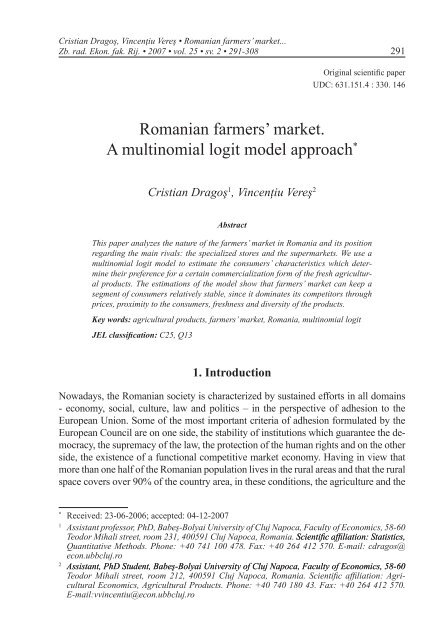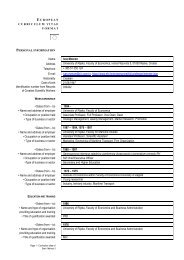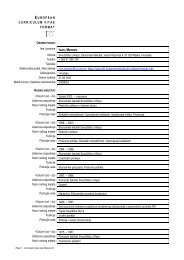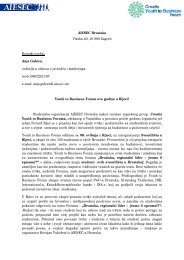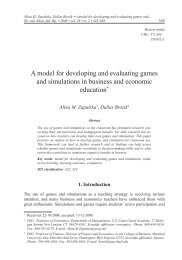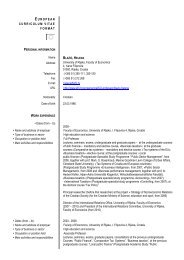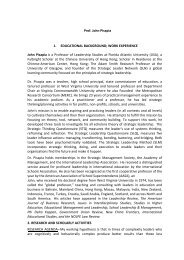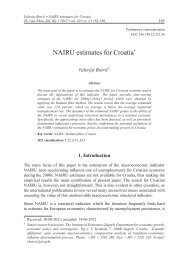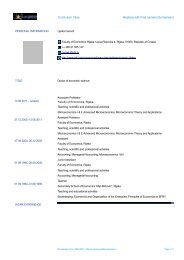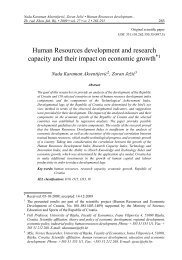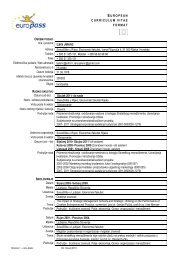Romanian farmers' market. A multinomial logit model approach*
Romanian farmers' market. A multinomial logit model approach*
Romanian farmers' market. A multinomial logit model approach*
You also want an ePaper? Increase the reach of your titles
YUMPU automatically turns print PDFs into web optimized ePapers that Google loves.
Cristian Dragoş, Vincenţiu Vereş • <strong>Romanian</strong> farmers’ <strong>market</strong>...Zb. rad. Ekon. fak. Rij. • 2007 • vol. 25 • sv. 2 • 291-308 291Original scientific paperUDC: 631.151.4 : 330. 146<strong>Romanian</strong> farmers’ <strong>market</strong>.A <strong>multinomial</strong> <strong>logit</strong> <strong>model</strong> approach *Cristian Dragoş 1 , Vincenţiu Vereş 2AbstractThis paper analyzes the nature of the farmers’ <strong>market</strong> in Romania and its positionregarding the main rivals: the specialized stores and the super<strong>market</strong>s. We use a<strong>multinomial</strong> <strong>logit</strong> <strong>model</strong> to estimate the consumers’ characteristics which determinetheir preference for a certain commercialization form of the fresh agriculturalproducts. The estimations of the <strong>model</strong> show that farmers’ <strong>market</strong> can keep asegment of consumers relatively stable, since it dominates its competitors throughprices, proximity to the consumers, freshness and diversity of the products.Key words: agricultural products, farmers’ <strong>market</strong>, Romania, <strong>multinomial</strong> <strong>logit</strong>JEL classification: C25, Q131. IntroductionNowadays, the <strong>Romanian</strong> society is characterized by sustained efforts in all domains- economy, social, culture, law and politics – in the perspective of adhesion to theEuropean Union. Some of the most important criteria of adhesion formulated by theEuropean Council are on one side, the stability of institutions which guarantee the democracy,the supremacy of the law, the protection of the human rights and on the otherside, the existence of a functional competitive <strong>market</strong> economy. Having in view thatmore than one half of the <strong>Romanian</strong> population lives in the rural areas and that the ruralspace covers over 90% of the country area, in these conditions, the agriculture and the*Received: 23-06-2006; accepted: 04-12-20071Assistant professor, PhD, Babeş-Bolyai University of Cluj Napoca, Faculty of Economics, 58-60Teodor Mihali street, room 231, 400591 Cluj Napoca, Romania. cientic Scientific afliation: affiliation: tatistics, Statistics,Quantitative Methods. Phone: +40 741 100 478. Fax: +40 264 412 570. E-mail: cdragos@econ.ubbcluj.ro2Assistant, PhD tudent, Babeş-Bolyai University of Cluj Napoca, Faculty of Economics, 58-60Assistant, PhD Student, Babeş-Bolyai University of Cluj Napoca, Faculty of Economics, 58-60Teodor Mihali street, room 212, 400591 Cluj Napoca, Romania. Scientific affiliation: AgriculturalEconomics, Agricultural Products. Phone: +40 740 180 43. Fax: +40 264 412 570.E-mail:vvincentiu@econ.ubbcluj.ro
Cristian Dragoş, Vincenţiu Vereş • <strong>Romanian</strong> farmers’ <strong>market</strong>...292 Zb. rad. Ekon. fak. Rij. • 2007 • vol. 25 • sv. 2 • 291-308rural economy, characterized by the existing level of performance and by the specificstructure, are very important in the process of adhesion to the E.U.The transition period through which Romania has been passing since the 1990s ischaracterized by a set of structural changes in the entire economy, in general, andin agriculture in particular. The most important legal text which has put its mark onthe agriculture is the law of the land number 18/1991. This was the legal base for theabolition of the agricultural production cooperatives (C.A.P.) and for the appropriationof the former owners according to the surface of land owned at the moment ofsubscription in the C.A.P. and the volume of performed labor. After this law, millionsof land owners have appeared. The problem is that most of them own very smallsurfaces of 1-2 ha. The problem of land property and the success of the agriculturalstructures reform are closely related to the evolution of the agricultural <strong>market</strong>, characterizedby major disparities between the offer and the demand of most of the basicagricultural productsThe agricultural <strong>market</strong> has many forms of existence, but when the commercializationof fresh agricultural products is concerned, the most important form is the farmers’<strong>market</strong>. However, in the past years, competitors such as specialized stores andsuper<strong>market</strong>s have become stronger on the agricultural <strong>market</strong>. If the farmers’ <strong>market</strong>sexisted and developed substantially before and after 1989, the same could not besaid either for specialized stores or for super<strong>market</strong>s. The latter began to spread onlyafter 1995, when a few super<strong>market</strong> chains, well-known over the world, decided tobuild their stores in the proximity of the largest cities. In spite of strong competition,the farmers’ <strong>market</strong>s continue to exist as the most important form of the commercewith fresh agricultural products.This article proposes an analysis of the perspectives of the farmers’ <strong>market</strong> facingthe strong competition of the other distribution agents – specialized stores and super<strong>market</strong>s.At the present in Romania, farmers <strong>market</strong>s occupy a privileged positionand dominate the mains competitive through price, proximity, freshness and qualityof the agricultural products and the range of agricultural products. On the basis ofa sample of consumers we study the elements which determine the behavior of theconsumers caught between the three types of commercialization forms. We use a<strong>multinomial</strong> <strong>logit</strong> <strong>model</strong> to estimate the consumers’ behavior.2. Literature reviewIn a historical perspective, in some developed countries from Europe and the USA,the farmers’ <strong>market</strong> was faced with a critical period from the beginning of the 20thcentury until the end of the 1990s, when it almost disappeared from the scene ofagricultural trade. However, in late 1990s the number of farmers’ <strong>market</strong>s has grownalmost exponentially.
Cristian Dragoş, Vincenţiu Vereş • <strong>Romanian</strong> farmers’ <strong>market</strong>...294 Zb. rad. Ekon. fak. Rij. • 2007 • vol. 25 • sv. 2 • 291-308search was to explain and understand the cultural relationships which bind the actorsof the <strong>market</strong> of agricultural products.Szmigin, Maddock and Carrigan (2003) talk about the farmers’ <strong>market</strong> as an alternativeto buying healthy, local, organic products. The main competitor - the super<strong>market</strong>– starts to be more and more the target of the consumer protests against thegenetically modified products and the origin of certain agricultural products.The farmers’ <strong>market</strong> is the subject of various studies and researches. The main aspectscovered by these studies are bound to the renewal of this phenomenon in thedeveloped countries, where after a long decline period, people have become moreand more aware of the benefits of the farmers’ <strong>market</strong>. Other researchers concentrateon the means by which the success of the farmers’ <strong>market</strong>s could be improved; meanwhilesome authors observe the intensification of competition between the farmers’<strong>market</strong>s on one side, and between the farmers’ <strong>market</strong> and the super<strong>market</strong>s on theother side (a well-known phenomenon, especially in the developing countries).The references mentioned above explain almost exhaustively the variables which influencethe behavior of the consumers regarding the decision to buy food stuffs fromthe farmers’ <strong>market</strong> or from other sources, as super<strong>market</strong>s or specialized stores.The variables characterize both the <strong>market</strong> type (the freshness and the quality ofagricultural products, the variety of assortment, the level of prices of the agriculturalproducts, the proximity of the <strong>market</strong> to the consumers’ residences, the possibilityto buy other products than fresh agricultural products) and the consumer (age andsex). As the consumer has three choices (three <strong>market</strong> types) the dependent variableis qualitative and we use a <strong>multinomial</strong> <strong>logit</strong> <strong>model</strong>.3. A note of farmers’ <strong>market</strong> situation in RomaniaThe farmers’ <strong>market</strong> situation is connected with the general situation of <strong>Romanian</strong>agriculture and is a reflection of problems that exist in the agrarian system. This situationis well presented by Otiman (1999) and Zahiu (2000):- in Romania over two thirds of farms poses under 5 hectare agricultural land andfrom that 60% poses less than 1 hectare;- over 50% of the <strong>Romanian</strong> population lives in rural areas and the principal occupationis agriculture;- <strong>Romanian</strong> agriculture is characterized by an advanced degree of lack of functioningof land improvement works;- The farmers’ access to the investment and development funds is making hard and theinterests perceived by the banks are extremely high for the realities in Romania;
Cristian Dragoş, Vincenţiu Vereş • <strong>Romanian</strong> farmers’ <strong>market</strong>...Zb. rad. Ekon. fak. Rij. • 2007 • vol. 25 • sv. 2 • 291-308 295In these conditions the great majority of farms are placed in the subsistence category.They are producing merely for the internal consumption of the farm. Parallel withthis phenomenon it can be observed a bigger and bigger interest of the farmers toproduce more for the <strong>market</strong>. So, in the last period the quantities of agricultural productshave grown, phenomenon observed by Istudor (2000).Farmers’ <strong>market</strong> is looked in a different way in Western Europe than in Romania.In Western Europe a farmers’ <strong>market</strong> is one at which farmers, growers or producersfrom a defined local area are present in person to sell their own product, directly tothe public. All products sold should have been grown, reared, caught, brewed, pickled,baked, smoked or processed by the stallholder. In Romania the farmers’ <strong>market</strong>is a special by arranged place from a locality destined for the commercialization ofthe agricultural or nonagricultural products. The main difference is that in the firstcase the local producers are protected by forbidding the access of producers that arefrom other geographical areas, while in Romania this “protectionism” is not presentand the farmers’ <strong>market</strong> is a mixture of agricultural, non agricultural or general useproducts commercialization. Because of that confusion the laws which establish thecommercialization through farmers’ <strong>market</strong>s are inadequate.Farmers’ <strong>market</strong>s in Romania are characterized by a poor organization and administrationfrom their managers. Their aspect and functioning principles are very old.Even if some <strong>market</strong>s are in process of modernization the phenomenon is relativelyof lower intensity. Also, farmers’ <strong>market</strong>s in Romania are characterized by tradition -a lot of them have existed from ancient times and have functioned at the same place,since then. If we are adding to this the fact that the placement of farmers’ <strong>market</strong>s isvery good (in the center of towns or cities) we can say that the farmers’ <strong>market</strong>s havea strong point in relation with the competition.Farmers’ <strong>market</strong> presents a high interest from the consumers because the prices arelower, the quality and freshness is better and the range of agricultural products ismore diversified than in specialized stores or super<strong>market</strong>s.Thus, over 57% consumers prefer farmers’ <strong>market</strong>s, 20% specialized stores and 23%super<strong>market</strong>s. This phenomenon exists even if the problems are big: the majorityof farmers’ <strong>market</strong>s are much deteriorated and the attitude of sellers is arrogant anddevoided of respect to wards consumers.4. Data and estimation <strong>model</strong>Our application involves consumers of fresh agricultural products. In June 2005,we made an empirical study on a sample of 138 individuals who perform the actof buying. Three different types of <strong>market</strong>s were taken into consideration: farmers’<strong>market</strong>s, specialized stores and super<strong>market</strong>s.
Cristian Dragoş, Vincenţiu Vereş • <strong>Romanian</strong> farmers’ <strong>market</strong>...296 Zb. rad. Ekon. fak. Rij. • 2007 • vol. 25 • sv. 2 • 291-3084.1. The sampleThe individuals from the sample were questioned about two kinds of variables: bothattributes that characterize the three alternatives: farmers’<strong>market</strong>, <strong>market</strong>, specialized store andsuper<strong>market</strong> and characteristics of the individual buys fresh agricultural products.Questionnaireregarding the fresh agricultural products consumers behaviorWe invite you to respond to the following questions:1. Where did you buy habitually the agricultural products? from the farmers’ <strong>market</strong> from the specialized store from the super<strong>market</strong>2. How do you appreciate the freshness and quality of the agricultural products forthe three alternatives?The freshness and quality of theagricultural products1. Very bad2. Bad3. Good4. Very good5. ExcellentFarmers’<strong>market</strong>SpecializedstoreSuper<strong>market</strong>3. How do you appreciate the range of agricultural products for the three alternatives?The range of agricultural products1. There is only a very limited rangeof agricultural products2. There is only a limited range ofagricultural products3. There is quite a large range ofagricultural products4. There is a large range ofagricultural products4. There is a very large range ofagricultural productsFarmers’<strong>market</strong>SpecializedstoreSuper<strong>market</strong>
Cristian Dragoş, Vincenţiu Vereş • <strong>Romanian</strong> farmers’ <strong>market</strong>...Zb. rad. Ekon. fak. Rij. • 2007 • vol. 25 • sv. 2 • 291-308 2974. How do you appreciate the price level of agricultural products for the three alternatives?The price level of agricultural productsFarmers’<strong>market</strong>SpecializedstoreSuper<strong>market</strong>1. Very high2. High3. Medium4. Low5. Very low5. How close from yours residence is the farmers’ <strong>market</strong>, the specialized store andthe super<strong>market</strong>?Proximity from the residenceFarmers’<strong>market</strong>SpecializedstoreSuper<strong>market</strong>1. Very far2. Far3. Close enough4. Close5. Very close6. How do you appreciate the existence or inexistence of other types of foods and/ordomestic products which do you need in the three alternatives?The possibility to find other productsFarmers’<strong>market</strong>SpecializedstoreSuper<strong>market</strong>1. I can’t find other products that Imay need2. I can find very few products that Ineed3. I can find few products that I need4. I can find quite enough productsthat I need5. I can find almost all the productsthat I need7. Age. You have ________ years8. Sex. You are Male Female
Cristian Dragoş, Vincenţiu Vereş • <strong>Romanian</strong> farmers’ <strong>market</strong>...298 Zb. rad. Ekon. fak. Rij. • 2007 • vol. 25 • sv. 2 • 291-3084.2. The <strong>model</strong>Supposing that each one of the individuals of the sample chooses only one type of<strong>market</strong> (commercialization form of the fresh agricultural products), the decision ofchoosing the <strong>market</strong> is discreet. Consequently, the <strong>model</strong> chosen for explaining thechoice is a discreet one, so the estimation is made using the econometrics of discreteregression and qualitative choice <strong>model</strong>s. The <strong>model</strong> is a <strong>multinomial</strong> one becausethe qualitative dependent variable y has more than two values, y i= j, j = 0, 1, ..., m,respectively. In our application, the values of y represent the three types of commercializationform.The <strong>multinomial</strong> <strong>logit</strong> <strong>model</strong>. The <strong>multinomial</strong> <strong>logit</strong> is actually an extension of thebinary <strong>logit</strong> <strong>model</strong>, having more than two values for the dependent variable. Let (p 0,p 1, ..., pm) be the probabilities of m+1 alternatives of choice. The probability of anindividual i to choose the alternative j is given by:exp( xibj)pij P(yi j)j 1,2,...,mm1 exp( x b )j1ij(1)where x iis the vector of the independent variables associated to the individual i, andb jis the vector of parameters associated to the alternative j.The conditional <strong>multinomial</strong> <strong>logit</strong> <strong>model</strong>. The generalization of the <strong>logit</strong> <strong>model</strong> forthe <strong>multinomial</strong> case is made by taking different parameters b jdepending on the alternativesof choice, such that the idependent variables x iremain constants dependingon the products. Still, there is another possibility: the McFadden’s conditional <strong>logit</strong><strong>model</strong> which considers a constant vector of parameters b and allows the independentvariables x ijto depend on the alternatives (McFadden 1974, 1980). The probabilityof an individual i to choose the product j is given by:exp( x b)exp(xb)ijijpij P(yi j)j 1,2 ,..., mmmexp( x b)1exp( x b)k 1ikk1ik(2)where x ij* = x ij- x i0, and the ratio of the probabilities is:P(yiP(yij)exp( xijb)exp( xijb) exp[( xij xil) b]l)exp( x b)exp( x b)ililj,l 1,2,..., m(3)which, as in the case of the <strong>multinomial</strong> <strong>logit</strong> is independent of the other alternativesof choice.
Cristian Dragoş, Vincenţiu Vereş • <strong>Romanian</strong> farmers’ <strong>market</strong>...Zb. rad. Ekon. fak. Rij. • 2007 • vol. 25 • sv. 2 • 291-308 299When computing the marginal effects, we are interested in the estimated variationof the probability of an individual i to choose the product j, when the independentvariable k associated to a product varies. We have:pijKexpx k1m1 expKijkh1 k 1bkxihkbk(4)and the marginal effectpxijilkbeing: bkpij(1 pij)bkpij(1 pil)ififj lj l(5)The general <strong>multinomial</strong> <strong>logit</strong> <strong>model</strong>. Due to the fact that our application involvesboth attributes of the <strong>market</strong>s and characteristics of the individual, we use a moregeneral <strong>model</strong>, which contains both the <strong>multinomial</strong> and the conditional <strong>logit</strong> <strong>model</strong>s.The probability for an individual i to choose the alternative j is given by:exp( xijb xibj)pij P(yi j)j,k 01, ,2,...,mmexp( x b x b )k 1ikik(6)Once the parameters have been estimated, by replacing the values of the independentvariables with the mean values from the sample, we can obtain an estimation of theprobability p~jthat a randomly chosen individual (average individual) will choosethe product j. By multiplying this number by the total number of consumers N, anestimation of the demand (or of the <strong>market</strong> share) for the choice (<strong>market</strong>) j can beobtained:~Dj ~ p NjWe can also obtain simulated <strong>market</strong> shares, computed for other values of the explicativevariables, thus facilitating the foundation of some governmental policies.The variablesChoice – the dependent variable (1 for the <strong>market</strong> type choose by the individual, 0for the other <strong>market</strong>s)(7)
Cristian Dragoş, Vincenţiu Vereş • <strong>Romanian</strong> farmers’ <strong>market</strong>...300 Zb. rad. Ekon. fak. Rij. • 2007 • vol. 25 • sv. 2 • 291-308Freshness – values from 1 to 5Diversity – values from 1 to 5Proximity – values from 1 to 5Price – values from 1 to 5Other products – values from 1 to 5Age – yearsSex – 0 if the individual is a woman, 1 if it is a man.Farmers’ <strong>market</strong> – dummy variable. Equal to 1 if farmers’ <strong>market</strong> is chosen, 0 otherwise.Specialized store – dummy variable. Equal to 1 if the specialized store is chosen, 0otherwise.Super<strong>market</strong> – dummy variable. Equal to 1 if the super<strong>market</strong> is chosen, 0 otherwise.Age_ farmers’ <strong>market</strong> = Age × farmers’ <strong>market</strong>Age_ specialized store = Age × specialized storeAge_ super<strong>market</strong> = Age × Super<strong>market</strong>Sex_ farmers’ <strong>market</strong> = Sex × farmers’ <strong>market</strong>Sex_ specialized store = Sex × specialized storeSex_ Super<strong>market</strong> = Sex × Super<strong>market</strong>4.3. Results presentationDescriptive statistics. Before we estimate the <strong>model</strong> we will present and discusssome descriptive statistics obtained in the sample.Table 1: The average values of variables in the sampleVariablesFreshnessDiversityProximityPriceOtherproductsSex(% males)Age(years)Farmers’ <strong>market</strong> 4.13 4.14 2.91 3.77 1.47 30.4 53.2Specialized store 2.21 2.49 4.01 2.62 2.99 39.3 44.6Super Market 2.91 3.7 2.35 3.74 4.46 51.6 40.2Source: Author’s calculations
Cristian Dragoş, Vincenţiu Vereş • <strong>Romanian</strong> farmers’ <strong>market</strong>...Zb. rad. Ekon. fak. Rij. • 2007 • vol. 25 • sv. 2 • 291-308 301The farmers’ <strong>market</strong> is above the mean value for the variables freshness and diversityof agricultural products. In what concerns the variable price, the values are abovethe mean for the farmers’ <strong>market</strong> and super<strong>market</strong> and the two values are very close.The farmers’ <strong>market</strong>s and of the super<strong>market</strong>s are not very close to the consumersresidence but specialized stores are. In consequence, the value for the proximity forspecialized stores is above the mean and for other two the values are underneath themean. In the super<strong>market</strong>s the consumers can find more products (agricultural ornonagricultural products) than in specialized stores or farmers’ <strong>market</strong>s. The valueof the variable other products for the super<strong>market</strong> is much over the mean, but for thefarmers’ <strong>market</strong> is much underneath the mean.The majority of consumers who choose the farmers’ <strong>market</strong> and specialized storesare women (70% respectively 60%). For the super<strong>market</strong>s the percentages are almostidentically between men and women. The average age of farmers’ <strong>market</strong> consumers(over 53 years) is very high but for super<strong>market</strong>s and specialized stores the age ofconsumers is between 40 and 45 years.The estimation of the <strong>model</strong>. For estimating the parameters, the LIMDEP 7.0 programwill be used and as an estimation algorithm, the Newton-Raphson method.Table 2: Parameters estimates - Discrete Choice (<strong>multinomial</strong> Logit) <strong>model</strong>Variable Coefficient Standard Dev. P[|Z|>z]Freshness 0.339 0.184 0.065Diversity 0.470 0.233 0.043Proximity 0.429 0.190 0.023Price 0.336 0.205 0.102Other products 1.404 0.258 0.000Age_farmers’ <strong>market</strong> 0.039 0.012 0.002Age_specialized store 0.000 fixed parameter -Age_super<strong>market</strong> -0.056 0.015 0.000Sex_farmers’ <strong>market</strong> -0.428 0.556 0.440Sex_specialized store 0.000 fixed parameter -Sex_super<strong>market</strong> 0.359 0.640 0.574Maximum Likelihood Estimates. Number of observations: 138. R-sqrd = 0.426Source: Author’s calculationsThe values of the parameters are according to expectations. The positive signs forfreshness, diversity, proximity, price and other products show an increased probabilityof choosing the alternative when the values of these variables increase. The posi-
Cristian Dragoş, Vincenţiu Vereş • <strong>Romanian</strong> farmers’ <strong>market</strong>...302 Zb. rad. Ekon. fak. Rij. • 2007 • vol. 25 • sv. 2 • 291-308tive sign for age_farmers’ <strong>market</strong> shows the fact that when age increases, it increasesthe probability of choosing farmers’ <strong>market</strong>, with respect to the reference alternative,the specialized store. The negative sign for age_super<strong>market</strong> shows the fact thatwhen age increases, it decreases the probability of choosing the super<strong>market</strong>, withrespect to the reference alternative, the specialized store. The parameters of the variablessex_farmers’ <strong>market</strong> and sex_super<strong>market</strong> are not statistically significant.For each individual, we can compute according to the formula (6) the probability ofchoosing each of the three alternatives (Table 3).Table 3: Predicted probabilities (* marks chosen, + marks prediction.)Individual Farmers’ <strong>market</strong> Specialized store Super<strong>market</strong>1 0.7434*+ 0.0516 0.20502 0.8554*+ 0.0378 0.10673 0.9645*+ 0.0152 0.0203……… …......... ………… …………80 0.3136 0.5573*+ 0.129081 0.7901 + 0.1736* 0.036382 0.5536 + 0.2036* 0.2428……… …........ ……….. …………136 0.3434 0.2545 0.4021*+137 0.1795 0.0060 0.8145*+138 0.0941 0.1907 0.7152*+Source: Author’s calculationsA study of the estimated probabilities shows that the <strong>model</strong> is a performant one fromthe point of view of the predictive accuracy, the percentage of correct prediction being74.6%.4.4. The applicability of the <strong>model</strong>We may consider the case when the values of the explicative variables change. Wecompute the marginal effects, the percentage variations of the share <strong>market</strong>s of theproducts respectively, when the variables: freshness, diversity, proximity, price andother products are increased by 1.
Cristian Dragoş, Vincenţiu Vereş • <strong>Romanian</strong> farmers’ <strong>market</strong>...Zb. rad. Ekon. fak. Rij. • 2007 • vol. 25 • sv. 2 • 291-308 303Table 4: The marginal effects (%) for the variable proximityThe alternative forwhich proximityvariesThe marginal effect over the alternativeFarmers’<strong>market</strong>SpecializedstoreSuper<strong>market</strong>Farmers’ <strong>market</strong> 6.31 -3.20 -3.11Specialized store -3.20 4.79 -1.59Super<strong>market</strong> -3.11 -1.59 4.70Source: Author’s calculationsThe results obtained are according to expectations: the increase of the proximity ofan alternative determines the increase of its <strong>market</strong> share. The <strong>market</strong> shares of theother alternatives decrease, but of different values. The increase of proximity for thesuper<strong>market</strong> has a greater impact over the farmers’ <strong>market</strong>. It can quantify the impactthat the construction of a new super<strong>market</strong> in a certain area will have on the farmers’<strong>market</strong>. The marginal effects calculated for the other variables are presented inTables 5-8:Table 5: The marginal effects (%) for the variable freshnessThe alternative forwhich freshnessvariesThe marginal effect over the alternativeFarmers’<strong>market</strong>SpecializedstoreSuper<strong>market</strong>Farmers’ <strong>market</strong> 4.99 -2.53 -2.46Specialized store -2.53 3.79 -1.26Super<strong>market</strong> -2.46 -1.26 3.71Source: Author’s calculationTable 6: The marginal effects (%) for the variable diversityThe alternative forwhich freshnessvariesThe marginal effect over the alternativeFarmers’<strong>market</strong>SpecializedstoreSuper<strong>market</strong>Farmers’ <strong>market</strong> 6.90 -3.50 -3.40Specialized store -3.50 5.24 -1.74Super<strong>market</strong> -3.40 -1.74 5.14Source: Author’s calculation
Cristian Dragoş, Vincenţiu Vereş • <strong>Romanian</strong> farmers’ <strong>market</strong>...304 Zb. rad. Ekon. fak. Rij. • 2007 • vol. 25 • sv. 2 • 291-308Table 7: The marginal effects (%) for the variable priceThe alternative forwhich freshnessvariesThe marginal effect over the alternativeFarmers’<strong>market</strong>SpecializedstoreSuper<strong>market</strong>Farmers’ <strong>market</strong> 4.93 -2.50 -2.43Specialized store -2.50 3.74 -1.24Super<strong>market</strong> -2.43 -1.24 3.67Source: Author’s calculationTable 8: The marginal effects (%) for the variable other productsThe alternative forwhich freshnessvariesThe marginal effect over the alternativeFarmers’<strong>market</strong>SpecializedstoreSuper<strong>market</strong>Farmers’ <strong>market</strong> 20.61 -10.46 -10.15Specialized store -10.46 15.65 -5.19Super<strong>market</strong> -10.15 -5.19 15.34Source: Author’s calculationThe <strong>model</strong> can be utilized too for estimating a correlation between the values ofthe consumers’ characteristics and the <strong>market</strong> share of each alternative. Consideringthis, we estimate the <strong>market</strong>s shares of the three alternatives, for different values ofthe variable age. The other variables keep their average values from the sample.Table 9: The estimated <strong>market</strong> shares (%) for the three alternativesAge20 30 40 50 60 70 80Farmers’ <strong>market</strong> 12.9 25.4 42.4 59.6 73.2 82.5 88.5Specialized store 15.2 20.3 22.8 21.7 18 13.7 9.9Super<strong>market</strong> 71.9 54.3 34.8 18.8 8.9 3.8 1.6Source: Author’s calculation
Cristian Dragoş, Vincenţiu Vereş • <strong>Romanian</strong> farmers’ <strong>market</strong>...Zb. rad. Ekon. fak. Rij. • 2007 • vol. 25 • sv. 2 • 291-308 305Figure 1: The estimated <strong>market</strong> shares with respect to the age908070<strong>market</strong> share (%)605040302010010 20 30 40 50 60 70 80 90age<strong>farmers'</strong> <strong>market</strong> . specialized store . super<strong>market</strong>Source: Based on the table 95. ConclusionsWe are contriving to explain different aspects of fresh agricultural products <strong>market</strong>using a <strong>multinomial</strong> <strong>logit</strong> <strong>model</strong>. The demand for each type of <strong>market</strong> is well predictedas well as the <strong>market</strong> attributes and characteristics of the individuals which determinethe consumers’ choice. The marginal effects obtained for each independentvariable are the signs that we expected. It would be easy to deduce what would be thechanges which might interfere in the <strong>market</strong> share structure as a result of variablesvalues changes. These results indicate the steps which governmental or local institutionshave to do for encouraging agricultural products commercialization forms.The three forms of commercialization can co-exist, each of them having a relativelyloyal consumer segment. As it can be seen from the results of the <strong>model</strong>, the youngpopulation prefers super <strong>market</strong>s, especially because of the possibility to purchaseother non-agricultural products at the same time. The older population and especiallythe retired people prefer farmers’ <strong>market</strong>s due to freshness, price and proximity totheir homes.We consider that it is an opportunity of <strong>Romanian</strong> farmers’ <strong>market</strong>s to expand dueto the fact that they have a high <strong>market</strong> share providing ecological and very diverseproducts. Moreover it insures a commercial <strong>market</strong> (outlet for small agricultural producers).The government should support farmers’ <strong>market</strong>s more through a suitablelegislation, fiscal measures and facilities for infrastructure investments.
Cristian Dragoş, Vincenţiu Vereş • <strong>Romanian</strong> farmers’ <strong>market</strong>...306 Zb. rad. Ekon. fak. Rij. • 2007 • vol. 25 • sv. 2 • 291-308From our study results that farmers’ <strong>market</strong>s occupy a privileged position in rapportwith the other two competitive forms: specialized stores and super<strong>market</strong>s. On theshort term, we estimate that farmers’ <strong>market</strong> will keep the actual segment of consumersrelatively unchanged, since it dominates its competitors through prices, proximityto the consumers, freshness and diversity of the products.ReferencesAndreatta, S., Wicklife, W. (2002) “Managing farmer and consumer expectations: Astudy of a North Carolina Farmers Market”, Human Organization, Vol.61, No.2,pp.167-176Agrawal, D., Schorling, C. (1996) “Market share forecasting: An empirical comparisonof artificial neural networks and <strong>multinomial</strong> <strong>logit</strong> <strong>model</strong>”, Journal ofRetailing, Vol.72, Issue 4 , pp.383-407Archer, G.P. et al. (2003) “Latent consumers’ attitude to farmers’ <strong>market</strong>s in NorthEngland”, British Food Journal, Vol.105, No.8, pp.487-497Atkinson, M., Williams, J. (1994) “Farmers’ <strong>market</strong>s”, Public Management, January,pp.16-20.Azam, P.J. (1991) “Peasant supply reponse under rationing: The role of the food<strong>market</strong>”, European Journal of Political Economy, Vol.7, Issue 3, pp.331-343.Bentz, Y., Merunka, D., (1996) “La modélisation du choix des marques par le modèle<strong>multinomial</strong> <strong>logit</strong> et les réseaux de neurones artificiels: proposition d’une approchehybride”, Recherche et Applications en Marketing, Vol. 11, No.2, pp.43–61Bingen, J., Serrano, A., Howard, J. (2003) “Linking farmers to <strong>market</strong>s: different approachesto human capital development”, Food Policy, Vol.28, Issue 4, pp.405-419.Bruhn, C. et al. (1992) “Consumer attitudes toward locally grown produce”, CaliforniaAgriculture, Vol.46, No.4, pp.13-16Cacho, J. (2003) “The super<strong>market</strong> „<strong>market</strong>” phenomenon in developing countries:Implications for smallholder farmers and investment”, American Journal of AgriculturalEconomics, vol.85, Issue 5, pp.11-62.Douglas, D.D., Bart, J.W. (2005) “Differentiated product competition and the AntitrustLogit Model: an experimental analysis”, Journal of Economic Behavior &Organization, Vol.57, Issue 1, pp.89-113.Gale, F. (1997) “Direct farm <strong>market</strong>ing as a rural development”, Rural DevelopmentPerspectives, Vol.12, No.2, pp.19-25.Gilg, A., Battershill, M. (1998) “Quality farm food in Europe: a possible alternativeto the industrialised food <strong>market</strong> and to current agri-environmental policies: lessonsfrom France”, Food Policy, Vol.23, Issue 1, pp.25-40.
Cristian Dragoş, Vincenţiu Vereş • <strong>Romanian</strong> farmers’ <strong>market</strong>...Zb. rad. Ekon. fak. Rij. • 2007 • vol. 25 • sv. 2 • 291-308 307Govindasamy, R. et al. (2003) “Producer satisfaction with returns from farmers’<strong>market</strong> related activity”, American Journal of Alternative Agriculture, Vol.18,Issue 2, pp.80-92Hinrichs, C. (2000) “Embeddness and local food system: notes on two types of agricultural<strong>market</strong>”, Journal of Rural Studies, Vol.16, Issue 3, pp.295-303Holloway, L., Kneafsey, M. (2000) “Reading the space of the farmers’ <strong>market</strong>: a preliminaryinvestigation from the UK”, Sociologia Ruralis, Vol.40, No.3, pp.285-299.Istudor, N. (2000) Modele de organizare a pieţelor agroalimentare pe <strong>model</strong>ul legumelorşi fructelor, Bucharest: Ed. Economica.McFadden, D. (1974) “Conditional Logit Analysis of Qualitative Choice Behavior”,Frontiers in Econometrics, New York: Academic Press, pp.105-142McFadden, D., (1980) “Econometric Models of Probabilistic Choice Among Products”,Journal of Bussines , No.53, pp.513-529Osborne T., (2005): Imperfect competition in agricultural <strong>market</strong>s: evidence fromEthiopia, Journal of Development Economics, Vol.76, Issue 2, pp.405-428.Otiman, P.I. (1999) Restructurarea agriculturii şi dezvoltarea rurală a României învederea aderării la Uniunea Europeană - un punct de vedere, Timisoara (Romania):Ed. Agroprint.Szmigin, I., Maddock, S., Carrigan, M. (2003) “Conceptualising community consumption:farmers’ <strong>market</strong>s and the older consumer”, British Food Journal,Vol.105, No.8, pp.542-550.Teng, D., Wilcock, A., Aung, M. (2004) “Cheese quality at farmers <strong>market</strong>s: observationof vendor practices and survey of consumer perceptions”, Food Control,Vol.15, Iss.7, pp.579-587.Tippins, M.J., Rassuli, M.K., Hollander, C.S. (2002) “An assessment of direct farmto-tablefood <strong>market</strong>ing in the USA”, International Journal of Retail & DistributionManagement, Vol.30, No.7, pp.343-353.Youngs, J. (2003) “Consumer direct initiatives in North West England farmers’ <strong>market</strong>s”,British Food Journal, Vol.105, No.8, pp.498-530.Wegren, K.S. (1994) “Building <strong>market</strong> institutions: Agricultural commodity exchangesin post-communist Russia”, Communist and Post-Communist Studies,Vol.27, Iss.3, pp.195-224.Zahiu, L., Lazar, T. (2000) Agricultura României în procesul de integrare agricolăeuropeană, Constanţa (Romania): Ed. ExPonto.
Cristian Dragoş, Vincenţiu Vereş • <strong>Romanian</strong> farmers’ <strong>market</strong>...308 Zb. rad. Ekon. fak. Rij. • 2007 • vol. 25 • sv. 2 • 291-308Rumunjsko tržište farmera.Pristup putem <strong>model</strong>a Logit MultinomialCristian Dragoş 1 , Vincenţiu Vereş 2SažetakOvaj članak analizira stanje tržišta farmera u Rumunjskoj i stav o glavnim suparnicima:specijalizirane trgovine i super<strong>market</strong>i. Koristi se <strong>logit</strong> <strong>model</strong> kako bi seprocijenilo one karakteristike potrošača koje određuju njihovu sklonost premaodređenom obliku komercijalizacije svježih poljoprivrednih proizvoda. Rezultati<strong>model</strong>a pokazuju da tržište farmera može zadržati jedan relativno stabilan segmentpotrošača jer je bolji od ostalih konkurenata po: cijeni, po zemljopisnom položajubliži je potrošačima, po svježini i raznolikosti proizvoda.Kljune ne ijei ijei rijei ijei ijei i: poljoprivredni proizvodi, tržište farmera, Rumunjska, <strong>logit</strong> multi-nomialJEL klasifikacija: C25, Q131Docent, Babeş-Bolyai Bolyai veučilište, veučilište, veučilište, Sveučilište, veučilište, veučilište, veučilište, Cluj Napoca, Ekonomski fakultet, Teodor Mihali 58-60,400591 Cluj Napoca, Rumunjska. Znanstveni interes: Statistika, tatistika, tatistika, tatistika, tatistika, tatistika, tatistika, tatistika, kvantitativne metode. Tel.:+40 741 100 478. Fax: +40 264 412 570. E-mail: cdragos@econ.ubbcluj.ro2Asistent, Doktorski student, Babeş-Bolyai veučilište, Sveučilište, Cluj Napoca, Ekonomski fakultet, TeodorMihali 58-60, 400591 Cluj Napoca, Rumunjska. Znanstveni interes: Poljoprivredni proizvodi.Tel.: +40 740 180 437, Fax: +40 264 412 57. E-mail: vvincentiu@econ.ubbcluj.ro


